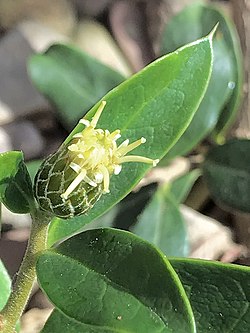| Archidasyphyllum | |
|---|---|
 | |
| Archidasyphyllum diacanthoides | |
| Scientific classification | |
| Kingdom: | Plantae |
| Clade: | Tracheophytes |
| Clade: | Angiosperms |
| Clade: | Eudicots |
| Clade: | Asterids |
| Order: | Asterales |
| Family: | Asteraceae |
| Subfamily: | Barnadesioideae |
| Tribe: | Barnadesieae |
| Genus: | Archidasyphyllum (Cabrera) P.L.Ferreira, Saavedra & Groppo |
Archidasyphyllum is a genus of flowering plants belonging to subfamily Barnadesioideae of the family Asteraceae. [1] [2]
Its native range is Central and Southern Chile to Southern Argentina. [1]
Species: [1]
- Archidasyphyllum diacanthoides (Less.) P.L.Ferreira, Saavedra & Groppo
- Archidasyphyllum excelsum (D.Don) P.L.Ferreira, Saavedra & Groppo